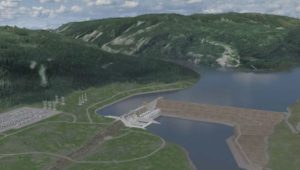British Columbians bracing for NDP economic hits

The Site C Energy Project in northern British Columbia. Source: BC Hydro
By Ellsworth Dickson

Vancouver radio station CKNW has reported that British Columbia’s NPD leader John Horgan wrote a letter to the president of BC Hydro asking them to stop work on the huge Site C Energy (dam) Project in northern BC.
As of today (June 5), John Horgan is not even premier of the province, although he expects to be shortly when his alliance with the Green Party will be enough for them to hold more seats than the BC Liberals. The Liberals have 43 seats, the NDP has 41 seats and the Greens have three.
With Premier Christy Clark still in power, Horgan does not have the authority to tell BC Hydro what to do. Horgan said he wants to conduct a review of the project. Understandably, Landowners near Site C as well as some First Nations are happy with Horgan’s move. However, like other mega projects, the government-approved Site C dam is meant for the greater good of the people of British Columbia.
The cancellation of the energy project, already under construction, will mean the loss of some 10,000 person-years of direct employment during construction and approximately 33,000 total person-years of employment through all stages of development and construction. The construction of Site C will result in an increase of $3.2 billion to the provincial gross domestic product (GDP), including a $130 million increase in regional GDP during construction.
If the Site C project is cancelled – now about a quarter of the way to completion – not only will it mean the loss of billions of dollars worth of planned construction, all that huge earth moving machinery will need to be trucked back to their headquarters and the 1,600-person accommodation trailers will have to be dismantled and moved. Then there are potential lawsuits from existing contractors.
A total of $40 million in tax revenues during construction to local governments is being generated, plus $2 million per year for local governments.
Capital costs for the project are estimated to be $8.8 billion. The Site C dam will provide 1,100 megawatts of electricity with no greenhouse gas emissions and produce about 5,100 gigawatts each year for the next hundred years. That’s enough power for 450,000 homes.
Regarding electricity demand, it’s also important to keep in mind that, while the move to electric cars is starting off slow, it is expected to pick up smartly in the next few years. As the electrification of BC’s auto fleet develops, more electricity will be needed for charging them as well as more power to heat homes as we gradually move away from fossil fuels.
While there are existing and planned wind, solar and run-of-river projects in BC, these are intermittent sources of power and can’t be counted on for a major base-load power source.
To date, BC Hydro has engaged about 60 Aboriginal groups for consultations and has provided over $14 million in funding for Aboriginal groups to participate in consultations regarding land-use studies and environmental assessments.
During March 2017, there were 2,252 workers at the Site C project. Of the total workers, 1,814 were from British Columbia, or 81%, all of whom are wondering if they will soon be unemployed.
Those concerned with the economic health of British Columbia may also want to contemplate the consequences of further potential NDP cancellations of major projects such as the $7.4 billion expansion of the federally-approved Kinder Morgan pipeline that, over its life, would generate $42 billion in tax revenues. This is a twinning of an existing pipeline from Edmonton, Alberta to Burnaby, BC that would increase the current 300,000 barrels per day to the West Coast to 890,000 barrels.
Opponents are worried that the increased tanker traffic off the BC coast will lead to a major oil spill. They may want to reflect on the fact that during the entire history of BC there has never been one significant oil spill. Since the Exxon Valdez oil spill in Alaska, all tankers are now double hulled and require a BC Pilot to navigate BC waters.
When, or if, the NDP becomes the BC government and they are able to significantly delay or cancel the pipeline twinning, will there be some sort of retaliation by Alberta? It is an ironic twist of fate that Alberta’s NDP Premier Rachel Notley is in the odd position of needing to get her province’s oil products to tidewater and on to market when BC’s NDP party does not want to accommodate her.
Another potential NDP financial hit will be its planned stoppage of the Massey Bridge Project that is designed to alleviate the province’s worst traffic bottleneck across the Fraser River between Richmond and Delta. When Mr. Horgan and Mr. Weaver were interviewed on CKNW, they said that the “mayors are against it”. This is a misleading statement. While some local mayors are against the Massey Bridge – now just starting construction – Mayor Lois Jackson of Delta (where the bridge goes) has been a proponent of the bridge for years.
British Columbia’s mining industry is now getting concerned about resource-related project cancellations or ones that may not even get off the ground due to lack of funding. Most junior mineral explorers raise exploration funds via private placements by investors able to stomach high risk. They won’t want further uncertainty. BC mining companies remember the downturn in their industrial sector during past times when the NDP was in power.
With British Columbia’s aging baby boomers needing more and more expensive health care services, one can only wonder at the wisdom of cancelling huge tax-generating projects.
